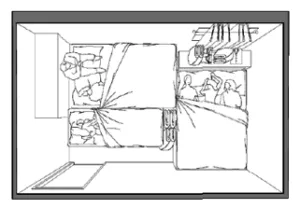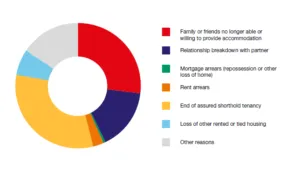The Green Book: 50 years on
Published: by Jenny Pennington
Shelter was launched to highlight a homelessness crisis. Now we are in the middle of another one.
Research launched today reveals that over a quarter of a million people in England are homeless. Most of these people are living in temporary accommodation provided by councils. Some are living in homeless hostels and some are sleeping rough. This is a conservative measurement. Many more people are homeless, but hidden.
These people cut your hair, sell you clothes and go to school with your children. And yet are reliant on the council, friends or a charity to have somewhere temporary to stay. Even more worryingly, this number has grown for the last five years.
What did we do?
In 1966, Shelter researchers travelled the country to expose the housing conditions that millions of families were suffering with. The data analysis and interviews with homeless families revealed the cruel reality of the housing market. Shortly after, Cathy Come Home, a dramatic realisation of similar stories, revealed this reality to the country.
50 years on, we have repeated this endeavour in order to understand the extent of homelessness, what it’s like to be homeless as a family and why families are being made homeless. We found that in the last fifty years, government and charities have made huge strides in addressing homelessness. But our housing shortage, alongside cuts to housing benefit, are once again taking some families back to these conditions.
What is it like to be homeless in 2016?
We spoke to fifty families who had experienced homelessness. Many homeless families live in temporary accommodation provided by their council. For some, this accommodation was a short-term solution to their needs. But some was truly shocking. We visited a family living in a twelve by eight foot room, in a block with twenty-nine other families. A sketch of the room shows how they were having to live.

On a practical level, homeless families found it much harder to work, to keep children warm, fed, rested and clean. On an emotional level, many felt overwhelmed by the idea they couldn’t meet their children’s basic needs. Some felt the same fear as Cathy in 1966: That one wrong turn could see the support disappear and lead to care proceedings that tore the family apart.
Why are people being made homeless?
Our research shows that we will struggle to end homelessness without addressing the housing problems that sit behind it. The government’s homelessness statistics show that the most common reason that people lose their home is because they are evicted by a private landlord.

We found that these statistics (pictured) could be under-counting the number of families made homeless due to problems with their housing. Most people we spoke to who had approached the council as they could no longer stay with a friend or family member, felt that this didn’t accurately reflect the reason they had been ‘made homeless’. Most had moved in with family friends once they had lost their home due to an eviction.
We also found that these government statistics miss out half the story. It’s not just about what causes someone to lose their home, but what prevents them from getting another.
Nowadays, many families have to move regularly, for example when they are evicted by their landlord thanks to our insecure private rented sector. Families end up at risk of homelessness when they are unable to find a new home. In the vast majority of cases, the barrier was finding somewhere to live that they could afford, and that would take people in need of housing benefit. This was the case even if families were working.
What must be done?
We must make every effort to remove these barriers that are tipping so many thousands of families into homelessness each year.
This means fixing our broken benefit system that is failing to protect families on low incomes. The government must end the current freeze on housing benefit for private renters and review benefit levels to ensure that they match rents.
But we must also fix England’s housing problems. The government must ensure that a quarter of a million houses are built every year – half of them genuinely affordable.
Only this will ensure that this problem is addressed. And only this will make sure that there is no reason to repeat this exercise in another fifty years.